《奈良真实性文件》20年的保护实践回顾与总结:《奈良+20》声明性文件译介
- 格式:pdf
- 大小:1.81 MB
- 文档页数:3
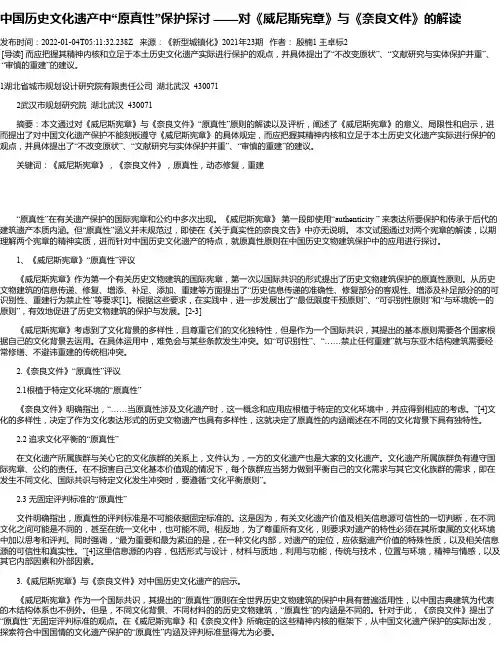
中国历史文化遗产中“原真性”保护探讨 ——对《威尼斯宪章》与《奈良文件》的解读发布时间:2022-01-04T05:11:32.238Z 来源:《新型城镇化》2021年23期作者:殷楠1 王卓标2 [导读] 而应把握其精神内核和立足于本土历史文化遗产实际进行保护的观点,并具体提出了“不改变原状”、“文献研究与实体保护并重”、“审慎的重建”的建议。
1湖北省城市规划设计研究院有限责任公司湖北武汉 4300712武汉市规划研究院湖北武汉 430071摘要:本文通过对《威尼斯宪章》与《奈良文件》“原真性”原则的解读以及评析,阐述了《威尼斯宪章》的意义、局限性和启示,进而提出了对中国文化遗产保护不能刻板遵守《威尼斯宪章》的具体规定,而应把握其精神内核和立足于本土历史文化遗产实际进行保护的观点,并具体提出了“不改变原状”、“文献研究与实体保护并重”、“审慎的重建”的建议。
关键词:《威尼斯宪章》,《奈良文件》,原真性,动态修复,重建“原真性”在有关遗产保护的国际宪章和公约中多次出现。
《威尼斯宪章》第一段即使用“authenticity ” 来表达所要保护和传承于后代的建筑遗产本质内涵。
但“原真性”涵义并未规范过,即使在《关于真实性的奈良文告》中亦无说明。
本文试图通过对两个宪章的解读,以期理解两个宪章的精神实质,进而针对中国历史文化遗产的特点,就原真性原则在中国历史文物建筑保护中的应用进行探讨。
1、《威尼斯宪章》“原真性”评议《威尼斯宪章》作为第一个有关历史文物建筑的国际宪章,第一次以国际共识的形式提出了历史文物建筑保护的原真性原则。
从历史文物建筑的信息传递、修复、增添、补足、添加、重建等方面提出了“历史信息传递的准确性、修复部分的客观性、增添及补足部分的的可识别性、重建行为禁止性”等要求[1]。
根据这些要求,在实践中,进一步发展出了“最低限度干预原则”、“可识别性原则”和“与环境统一的原则”,有效地促进了历史文物建筑的保护与发展。
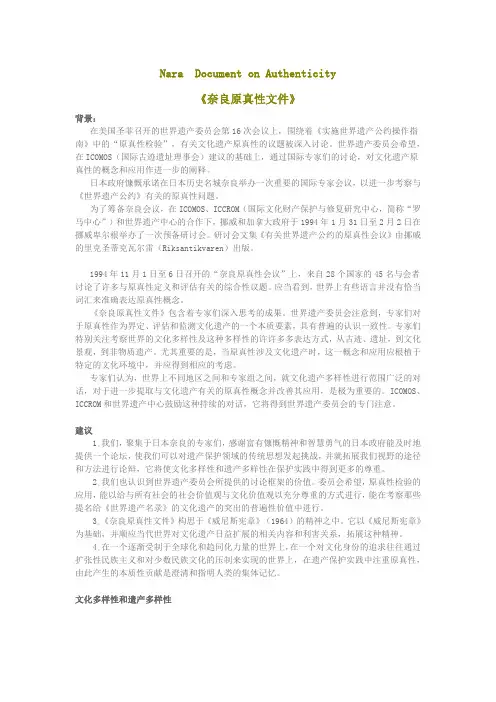
Nara Document on Authenticity《奈良原真性文件》背景:在美国圣菲召开的世界遗产委员会第16次会议上,围绕着《实施世界遗产公约操作指南》中的“原真性检验”,有关文化遗产原真性的议题被深入讨论。
世界遗产委员会希望,在ICOMOS(国际古迹遗址理事会)建议的基础上,通过国际专家们的讨论,对文化遗产原真性的概念和应用作进一步的阐释。
日本政府慷慨承诺在日本历史名城奈良举办一次重要的国际专家会议,以进一步考察与《世界遗产公约》有关的原真性问题。
为了筹备奈良会议,在ICOMOS、ICCROM(国际文化财产保护与修复研究中心,简称“罗马中心”)和世界遗产中心的合作下,挪威和加拿大政府于1994年1月31日至2月2日在挪威卑尔根举办了一次预备研讨会。
研讨会文集《有关世界遗产公约的原真性会议》由挪威的里克圣蒂克瓦尔雷(Riksantikvaren)出版。
1994年11月1日至6日召开的“奈良原真性会议”上,来自28个国家的45名与会者讨论了许多与原真性定义和评估有关的综合性议题。
应当看到,世界上有些语言并没有恰当词汇来准确表达原真性概念。
《奈良原真性文件》包含着专家们深入思考的成果。
世界遗产委员会注意到,专家们对于原真性作为界定、评估和监测文化遗产的一个本质要素,具有普遍的认识一致性。
专家们特别关注考察世界的文化多样性及这种多样性的许许多多表达方式,从古迹、遗址,到文化景观,到非物质遗产。
尤其重要的是,当原真性涉及文化遗产时,这一概念和应用应根植于特定的文化环境中,并应得到相应的考虑。
专家们认为,世界上不同地区之间和专家组之间,就文化遗产多样性进行范围广泛的对话,对于进一步提取与文化遗产有关的原真性概念并改善其应用,是极为重要的。
ICOMOS、ICCROM和世界遗产中心鼓励这种持续的对话,它将得到世界遗产委员会的专门注意。
建议1.我们,聚集于日本奈良的专家们,感谢富有慷慨精神和智慧勇气的日本政府能及时地提供一个论坛,使我们可以对遗产保护领域的传统思想发起挑战,并就拓展我们视野的途径和方法进行论辩,它将使文化多样性和遗产多样性在保护实践中得到更多的尊重。
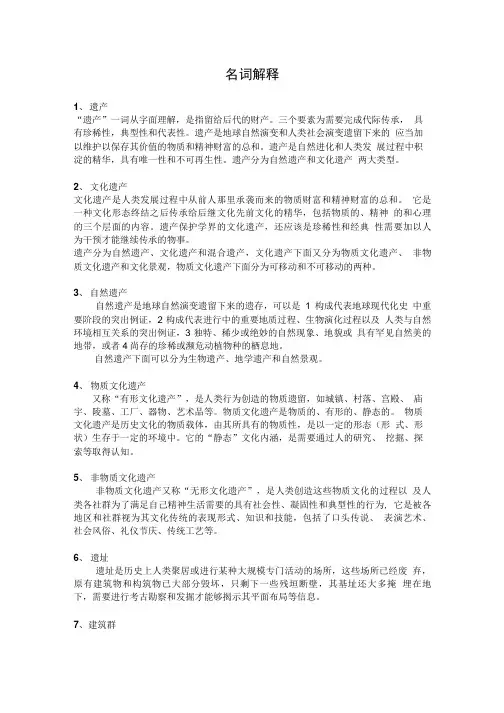
名词解释1、遗产“遗产”一词从字面理解,是指留给后代的财产。
三个要素为需要完成代际传承,具有珍稀性,典型性和代表性。
遗产是地球自然演变和人类社会演变遗留下来的应当加以维护以保存其价值的物质和精神财富的总和。
遗产是自然进化和人类发展过程中积淀的精华,具有唯一性和不可再生性。
遗产分为自然遗产和文化遗产两大类型。
2、文化遗产文化遗产是人类发展过程中从前人那里承袭而来的物质财富和精神财富的总和。
它是一种文化形态终结之后传承给后继文化先前文化的精华,包括物质的、精神的和心理的三个层面的内容。
遗产保护学界的文化遗产,还应该是珍稀性和经典性需要加以人为干预才能继续传承的物事。
遗产分为自然遗产、文化遗产和混合遗产,文化遗产下面又分为物质文化遗产、非物质文化遗产和文化景观,物质文化遗产下面分为可移动和不可移动的两种。
3、自然遗产自然遗产是地球自然演变遗留下来的遗存,可以是1构成代表地球现代化史中重要阶段的突出例证,2构成代表进行中的重要地质过程、生物演化过程以及人类与自然环境相互关系的突出例证,3独特、稀少或绝妙的自然现象、地貌或具有罕见自然美的地带,或者4尚存的珍稀或濒危动植物种的栖息地。
自然遗产下面可以分为生物遗产、地学遗产和自然景观。
4、物质文化遗产又称“有形文化遗产”,是人类行为创造的物质遗留,如城镇、村落、宫殿、庙宇、陵墓、工厂、器物、艺术品等。
物质文化遗产是物质的、有形的、静态的。
物质文化遗产是历史文化的物质载体,由其所具有的物质性,是以一定的形态(形式、形状)生存于一定的环境中。
它的“静态”文化内涵,是需要通过人的研究、挖掘、探索等取得认知。
5、非物质文化遗产非物质文化遗产又称“无形文化遗产”,是人类创造这些物质文化的过程以及人类各社群为了满足自己精神生活需要的具有社会性、凝固性和典型性的行为, 它是被各地区和社群视为其文化传统的表现形式、知识和技能,包括了口头传说、表演艺术、社会风俗、礼仪节庆、传统工艺等。
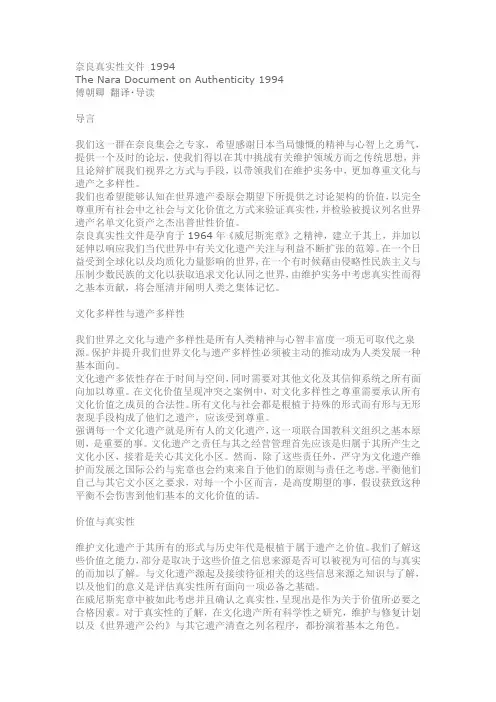
奈良真实性文件1994The Nara Document on Authenticity 1994傅朝卿翻译‧导读导言我们这一群在奈良集会之专家,希望感谢日本当局慷慨的精神与心智上之勇气,提供一个及时的论坛,使我们得以在其中挑战有关维护领域方而之传统思想,并且论辩扩展我们视界之方式与手段,以带领我们在维护实务中,更加尊重文化与遗产之多样性。
我们也希望能够认知在世界遗产委原会期望下所提供之讨论架构的价值,以完全尊重所有社会中之社会与文化价值之方式来验证真实性,并检验被提议列名世界遗产名单文化资产之杰出普世性价值。
奈良真实性文件是孕育于1964年《威尼斯宪章》之精神,建立于其上,并加以延伸以响应我们当代世界中有关文化遗产关注与利益不断扩张的范筹。
在一个日益受到全球化以及均质化力量影响的世界,在一个有时候藉由侵略性民族主义与压制少数民族的文化以获取追求文化认同之世界,由维护实务中考虑真实性而得之基本贡献,将会厘清并阐明人类之集体记忆。
文化多样性与遗产多样性我们世界之文化与遗产多样性是所有人类精神与心智丰富度一项无可取代之泉源。
保护并提升我们世界文化与遗产多样性必须被主动的推动成为人类发展一种基本面向。
文化遗产多依性存在于时间与空间,同时需要对其他文化及其信仰系统之所有面向加以尊重。
在文化价值呈现冲突之案例中,对文化多样性之尊重需要承认所有文化价值之成员的合法性。
所有文化与社会都是根植于持殊的形式而有形与无形表现手段构成了他们之遗产,应该受到尊重。
强调每一个文化遗产就是所有人的文化遗产,这一项联合国教科文组织之基本原则,是重要的事。
文化遗产之责任与其之经营管理首先应该是归属于其所产生之文化小区,接着是关心其文化小区。
然而,除了这些责任外,严守为文化遗产维护而发展之国际公约与宪章也会约束来自于他们的原则与责任之考虑。
平衡他们自己与其它文小区之要求,对每一个小区而言,是高度期望的事,假设获致这种平衡不会伤害到他们基本的文化价值的话。
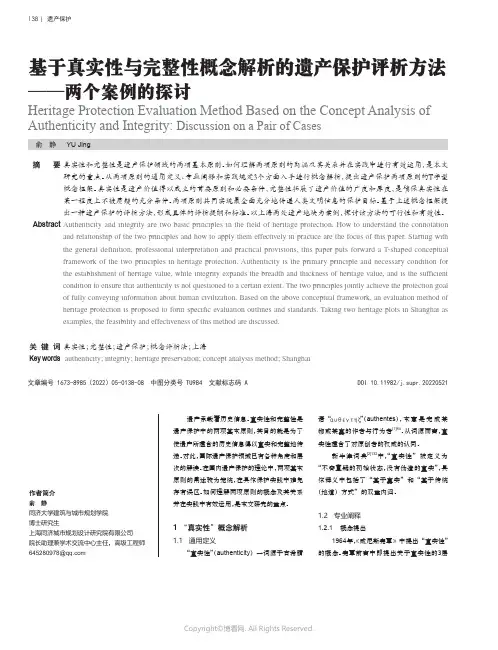
138 | 遗产保护Heritage Protection Evaluation Method Based on the Concept Analysis of Authenticity and Integrity: Discussion on a Pair of Cases基于真实性与完整性概念解析的遗产保护评析方法——两个案例的探讨俞 静 YU Jing真实性和完整性是遗产保护领域的两项基本原则。
如何理解两项原则的内涵及其关系并在实践中进行有效运用,是本文研究的重点。
从两项原则的通用定义、专业阐释和实践规定3个方面入手进行概念解析,提出遗产保护两项原则的T字型概念框架。
真实性是遗产价值得以成立的首要原则和必要条件,完整性拓展了遗产价值的广度和厚度,是确保真实性在某一程度上不被质疑的充分条件。
两项原则共同实现最全面充分地传递人类文明信息的保护目标。
基于上述概念框架提出一种遗产保护的评析方法,形成具体的评析提纲和标准。
以上海两处遗产地块为案例,探讨该方法的可行性和有效性。
Authenticity and integrity are two basic principles in the field of heritage protection. How to understand the connotationand relationship of the two principles and how to apply them effectively in practice are the focus of this paper. Starting with the general definition, professional interpretation and practical provisions, this paper puts forward a T-shaped conceptual framework of the two principles in heritage protection. Authenticity is the primary principle and necessary condition for the establishment of heritage value, while integrity expands the breadth and thickness of heritage value, and is the sufficient condition to ensure that authenticity is not questioned to a certain extent. The two principles jointly achieve the protection goal of fully conveying information about human civilization. Based on the above conceptual framework, an evaluation method of heritage protection is proposed to form specific evaluation outlines and standards. Taking two heritage plots in Shanghai as examples, the feasibility and effectiveness of this method are discussed.真实性;完整性;遗产保护;概念评析法;上海authenticity; integrity; heritage preservation; concept analysis method; Shanghai文章编号 1673-8985(2022)05-0138-08 中图分类号 TU984 文献标志码 A DOI 10.11982/j.supr.20220521摘 要Abstract 关 键 词Key words 作者简介俞 静同济大学建筑与城市规划学院博士研究生上海同济城市规划设计研究院有限公司院长助理兼学术交流中心主任,高级工程师****************遗产承载着历史信息。

维尼斯宪章——奈良真实性文件——北京文件国际古迹保护与修复宪章(第二届历史古迹建筑师及技师国际会议于1964年5月25日——31日在威尼斯通过)发文单位:第二届历史古迹建筑师及技师国际会议发文时间:1964-5-25生效日期:1964-5-25世世代代人民的历史古迹,饱含着过去岁月的信息留存至今,成为人们古老的活的见证。
人们越来越意识到人类价值的统一性,并把古代遗迹看作共同的遗产,认识到为后代保护这些古迹的共同责任。
将它们真实地、完整地传下去是我们的职责。
古代建筑的保护与修复指导原则应在国际上得到公认并作出规定,这一点至关重要。
各国在各自的文化和传统范畴内负责实施这一规划。
1931年的雅典宪章第一次规定了这些基本原则,为一个国际运动的广泛发展做出了贡献,这一运动所采取的具体形式体现在各国的文件之中,体现在国际博物馆协会和联合国教育、科学及文化组织的工作之中,以及在由后者建立的国际文化财产保护与修复研究中心之中。
一些已经并在继续变得更为复杂和多样化的问题已越来越受到注意,并展开了紧急研究。
现在,重新审阅宪章的时候已经来临,以便对其所含原则进行彻底研究,并在一份新文件中扩大其范围。
为此,1964年5月25日?31日在威尼斯召开了第二届历史古迹建筑师及技师国际会议,通过了以下文本:定义第一条历史古迹的要领不仅包括单个建筑物,而且包括能从中找出一种独特的文明、一种有意义的发展或一个历史事件见证的城市或乡村环境。
这不仅适用于伟大的艺术作品,而且亦适用于随时光逝而获得文化意义的过去一些较为朴实的艺术品。
第二条古迹的保护与修复必须求助于对研究和保护考古遗产有利的一切科学技术。
宗旨第三条保护与修复古迹的目的旨在把它们既作为历史见证,又作为艺术品予以保护。
保护第四条古迹的保护至关重要的一点在于日常的维护。
第五条为社会公用之目的使用古迹永远有利于古迹的保护。
因此,这种使用合乎需要,但决不能改变该建筑的布局或装饰。
只有在此限度内才可考虑或允许因功能改变而需做的改动。
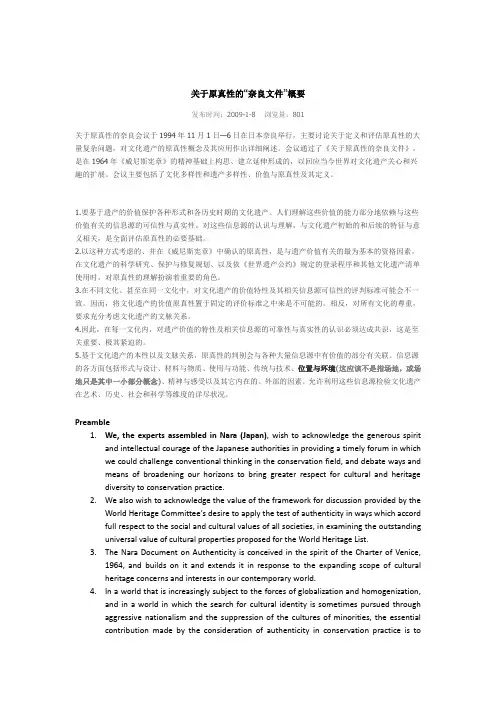
关于原真性的“奈良文件”概要发布时间:2009-1-8 浏览量:801关于原真性的奈良会议于1994年11月1日—6日在日本奈良举行,主要讨论关于定义和评估原真性的大量复杂问题,对文化遗产的原真性概念及其应用作出详细阐述。
会议通过了《关于原真性的奈良文件》,是在1964年《威尼斯宪章》的精神基础上构思、建立延伸形成的,以回应当今世界对文化遗产关心和兴趣的扩展。
会议主要包括了文化多样性和遗产多样性、价值与原真性及其定义。
1.要基于遗产的价值保护各种形式和各历史时期的文化遗产。
人们理解这些价值的能力部分地依赖与这些价值有关的信息源的可信性与真实性。
对这些信息源的认识与理解,与文化遗产初始的和后续的特征与意义相关,是全面评估原真性的必要基础。
2.以这种方式考虑的、并在《威尼斯宪章》中确认的原真性,是与遗产价值有关的最为基本的资格因素。
在文化遗产的科学研究、保护与修复规划、以及依《世界遗产公约》规定的登录程序和其他文化遗产清单使用时,对原真性的理解扮演着重要的角色。
3.在不同文化、甚至在同一文化中,对文化遗产的价值特性及其相关信息源可信性的评判标准可能会不一致。
因而,将文化遗产的价值原真性置于固定的评价标准之中来是不可能的。
相反,对所有文化的尊重,要求充分考虑文化遗产的文脉关系。
4.因此,在每一文化内,对遗产价值的特性及相关信息源的可靠性与真实性的认识必须达成共识,这是至关重要、极其紧迫的。
5.基于文化遗产的本性以及文脉关系,原真性的判别会与各种大量信息源中有价值的部分有关联。
信息源的各方面包括形式与设计、材料与物质、使用与功能、传统与技术、位置与环境(这应该不是指场地,或场地只是其中一小部分概念)、精神与感受以及其它内在的、外部的因素。
允许利用这些信息源检验文化遗产在艺术、历史、社会和科学等维度的详尽状况。
Preamble1.We, the experts assembled in Nara (Japan), wish to acknowledge the generous spiritand intellectual courage of the Japanese authorities in providing a timely forum in which we could challenge conventional thinking in the conservation field, and debate ways and means of broadening our horizons to bring greater respect for cultural and heritage diversity to conservation practice.2.We also wish to acknowledge the value of the framework for discussion provided by theWorld Heritage Committee's desire to apply the test of authenticity in ways which accord full respect to the social and cultural values of all societies, in examining the outstanding universal value of cultural properties proposed for the World Heritage List.3.The Nara Document on Authenticity is conceived in the spirit of the Charter of Venice,1964, and builds on it and extends it in response to the expanding scope of cultural heritage concerns and interests in our contemporary world.4.In a world that is increasingly subject to the forces of globalization and homogenization,and in a world in which the search for cultural identity is sometimes pursued through aggressive nationalism and the suppression of the cultures of minorities, the essential contribution made by the consideration of authenticity in conservation practice is toclarify and illuminate the collective memory of humanity.Cultural Diversity and Heritage Diversity5.The diversity of cultures and heritage in our world is an irreplaceable source of spiritualand intellectual richness for all humankind. The protection and enhancement of cultural and heritage diversity in our world should be actively promoted as an essential aspect of human development.6.Cultural heritage diversity exists in time and space, and demands respect for othercultures and all aspects of their belief systems. In cases where cultural values appear to be in conflict, respect for cultural diversity demands acknowledgment of the legitimacy of the cultural values of all parties.7.All cultures and societies are rooted in the particular forms and means of tangible andintangible expression which constitute their heritage, and these should be respected.8.It is important to underline a fundamental principle of UNESCO, to the effect that thecultural heritage of each is the cultural heritage of all. Responsibility for cultural heritage and the management of it belongs, in the first place, to the cultural community that has generated it, and subsequently to that which cares for it. However, in addition to these responsibilities, adherence to the international charters and conventions developed for conservation of cultural heritage also obliges consideration of the principles and responsibilities flowing from them. Balancing their own requirements with those of other cultural communities is, for each community, highly desirable, provided achieving this balance does not undermine their fundamental cultural values.Values and authenticity9.Conservation of cultural heritage in all its forms and historical periods is rooted in thevalues attributed to the heritage. Our ability to understand these values depends, in part, on the degree to which information sources about these values may be understood as credible or truthful. Knowledge and understanding of these sources of information, in relation to original and subsequent characteristics of the cultural heritage, and their meaning, is a requisite basis for assessing all aspects of authenticity.10.Authenticity, considered in this way and affirmed in the Charter of Venice, appears as theessential qualifying factor concerning values. The understanding of authenticity plays a fundamental role in all scientific studies of the cultural heritage, in conservation and restoration planning, as well as within the inscription procedures used for the World Heritage Convention and other cultural heritage inventories.11.All judgements about values attributed to cultural properties as well as the credibility ofrelated information sources may differ from culture to culture, and even within the same culture. It is thus not possible to base judgements of values and authenticity within fixed criteria. On the contrary, the respect due to all cultures requires that heritage properties must considered and judged within the cultural contexts to which they belong.12.Therefore, it is of the highest importance and urgency that, within each culture,recognition be accorded to the specific nature of its heritage values and the credibility and truthfulness of related information sources.13.Depending on the nature of the cultural heritage, its cultural context, and its evolutionthrough time, authenticity judgements may be linked to the worth of a great variety of sources of information. Aspects of the sources may include form and design, materialsand substance, use and function, traditions and techniques, location and setting, and spirit and feeling, and other internal and external factors. The use of these sources permits elaboration of the specific artistic, historic, social, and scientific dimensions of the cultural heritage being examined.Appendix 1Suggestions for follow-up (proposed by H. Stovel)1.Respect for cultural and heritage diversity requires conscious efforts to avoid imposingmechanistic formulae or standardized procedures in attempting to define or determine authenticity of particular monuments and sites.2.Efforts to determine authenticity in a manner respectful of cultures and heritagediversity requires approaches which encourage cultures to develop analytical processes and tools specific to their nature and needs. Such approaches may have several aspects in common:o efforts to ensure assessment of authenticity involve multidisciplinary collaboration and the appropriate utilisation of all available expertise andknowledge;o efforts to ensure attributed values are truly representative of a culture and the diversity of its interests, in particular monuments and sites;o efforts to document clearly the particular nature of authenticity for monuments and sites as a practical guide to future treatment and monitoring;o efforts to update authenticity assessments in light of changing values and circumstances.3.Particularly important are efforts to ensure that attributed values are respected, and thattheir determination included efforts to build, ad far as possible, a multidisciplinary and community consensus concerning these values.4.Approaches should also build on and facilitate international co-operation among allthose with an interest in conservation of cultural heritage, in order to improve global respect and understanding for the diverse expressions and values of each culture.5.Continuation and extension of this dialogue to the various regions and cultures of theworld is a prerequisite to increasing the practical value of consideration of authenticity in the conservation of the common heritage of humankind..6.Increasing awareness within the public of this fundamental dimension of heritage is anabsolute necessity in order to arrive at concrete measures for safeguarding the vestiges of the past. This means developing greater understanding of the values represented by the cultural properties themselves, as well as respecting the role such monuments and sites play in contemporary society.Appendix IIDefinitionsConservation: all efforts designed to understand cultural heritage, know its history and meaning, ensure its material safeguard and, as required, its presentation, restoration and enhancement.(Cultural heritage is understood to include monuments, groups of buildings and sites of cultural value as defined in article one of the World Heritage Convention).Information sources: all material, written, oral and figurative sources which make it possible to know the nature, specifications, meaning and history of the cultural heritage.The Nara Document on Authenticity was drafted by the 45 participants at the Nara Conference on Authenticity in Relation to the World Heritage Convention, held at Nara, Japan, from 1-6 November 1994, at the invitation of the Agency for Cultural Affairs (Government of Japan) and the Nara Prefecture. The Agency organized the Nara Conference in cooperation with UNESCO, ICCROM and ICOMOS.This final version of the Nara Document has been edited by the general rapporteurs of the Nara Conference, Mr. Raymond Lemaire and Mr. Herb Stovel.。
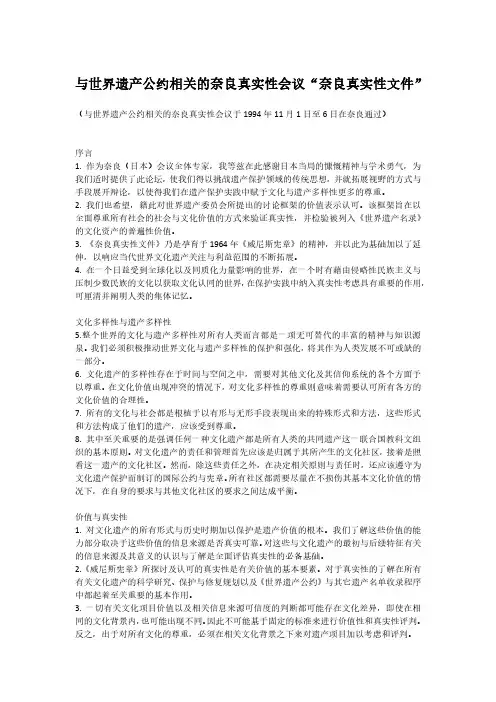
与世界遗产公约相关的奈良真实性会议“奈良真实性文件”(与世界遗产公约相关的奈良真实性会议于1994年11月1日至6日在奈良通过)序言1. 作为奈良(日本)会议全体专家,我等兹在此感谢日本当局的慷慨精神与学术勇气,为我们适时提供了此论坛,使我们得以挑战遗产保护领域的传统思想,并就拓展视野的方式与手段展开辩论,以使得我们在遗产保护实践中赋予文化与遗产多样性更多的尊重。
2. 我们也希望,籍此对世界遗产委员会所提出的讨论框架的价值表示认可。
该框架旨在以全面尊重所有社会的社会与文化价值的方式来验证真实性,并检验被列入《世界遗产名录》的文化资产的普遍性价值。
3. 《奈良真实性文件》乃是孕育于1964年《威尼斯宪章》的精神,并以此为基础加以了延伸,以响应当代世界文化遗产关注与利益范围的不断拓展。
4. 在一个日益受到全球化以及同质化力量影响的世界,在一个时有藉由侵略性民族主义与压制少数民族的文化以获取文化认同的世界,在保护实践中纳入真实性考虑具有重要的作用,可厘清并阐明人类的集体记忆。
文化多样性与遗产多样性5.整个世界的文化与遗产多样性对所有人类而言都是一项无可替代的丰富的精神与知识源泉。
我们必须积极推动世界文化与遗产多样性的保护和强化,将其作为人类发展不可或缺的一部分。
6. 文化遗产的多样性存在于时间与空间之中,需要对其他文化及其信仰系统的各个方面予以尊重。
在文化价值出现冲突的情况下,对文化多样性的尊重则意味着需要认可所有各方的文化价值的合理性。
7. 所有的文化与社会都是根植于以有形与无形手段表现出来的特殊形式和方法,这些形式和方法构成了他们的遗产,应该受到尊重。
8. 其中至关重要的是强调任何一种文化遗产都是所有人类的共同遗产这一联合国教科文组织的基本原则。
对文化遗产的责任和管理首先应该是归属于其所产生的文化社区,接着是照看这一遗产的文化社区。
然而,除这些责任之外,在决定相关原则与责任时,还应该遵守为文化遗产保护而制订的国际公约与宪章。

奈良真实性文件1994The Nara Document on Authenticity 1994傅朝卿翻译‧导读导言我们这一群在奈良集会之专家,希望感谢日本当局慷慨的精神与心智上之勇气,提供一个及时的论坛,使我们得以在其中挑战有关维护领域方而之传统思想,并且论辩扩展我们视界之方式与手段,以带领我们在维护实务中,更加尊重文化与遗产之多样性。
我们也希望能够认知在世界遗产委原会期望下所提供之讨论架构的价值,以完全尊重所有社会中之社会与文化价值之方式来验证真实性,并检验被提议列名世界遗产名单文化资产之杰出普世性价值。
奈良真实性文件是孕育于1964年《威尼斯宪章》之精神,建立于其上,并加以延伸以响应我们当代世界中有关文化遗产关注与利益不断扩张的范筹。
在一个日益受到全球化以及均质化力量影响的世界,在一个有时候藉由侵略性民族主义与压制少数民族的文化以获取追求文化认同之世界,由维护实务中考虑真实性而得之基本贡献,将会厘清并阐明人类之集体记忆。
文化多样性与遗产多样性我们世界之文化与遗产多样性是所有人类精神与心智丰富度一项无可取代之泉源。
保护并提升我们世界文化与遗产多样性必须被主动的推动成为人类发展一种基本面向。
文化遗产多依性存在于时间与空间,同时需要对其他文化及其信仰系统之所有面向加以尊重。
在文化价值呈现冲突之案例中,对文化多样性之尊重需要承认所有文化价值之成员的合法性。
所有文化与社会都是根植于持殊的形式而有形与无形表现手段构成了他们之遗产,应该受到尊重。
强调每一个文化遗产就是所有人的文化遗产,这一项联合国教科文组织之基本原则,是重要的事。
文化遗产之责任与其之经营管理首先应该是归属于其所产生之文化小区,接着是关心其文化小区。
然而,除了这些责任外,严守为文化遗产维护而发展之国际公约与宪章也会约束来自于他们的原则与责任之考虑。
平衡他们自己与其它文小区之要求,对每一个小区而言,是高度期望的事,假设获致这种平衡不会伤害到他们基本的文化价值的话。
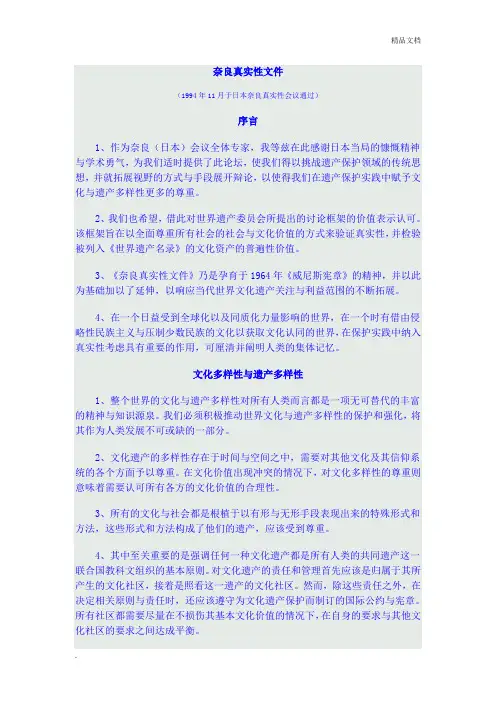
奈良真实性文件(1994年11月于日本奈良真实性会议通过)序言1、作为奈良(日本)会议全体专家,我等兹在此感谢日本当局的慷慨精神与学术勇气,为我们适时提供了此论坛,使我们得以挑战遗产保护领域的传统思想,并就拓展视野的方式与手段展开辩论,以使得我们在遗产保护实践中赋予文化与遗产多样性更多的尊重。
2、我们也希望,借此对世界遗产委员会所提出的讨论框架的价值表示认可。
该框架旨在以全面尊重所有社会的社会与文化价值的方式来验证真实性,并检验被列入《世界遗产名录》的文化资产的普遍性价值。
3、《奈良真实性文件》乃是孕育于1964年《威尼斯宪章》的精神,并以此为基础加以了延伸,以响应当代世界文化遗产关注与利益范围的不断拓展。
4、在一个日益受到全球化以及同质化力量影响的世界,在一个时有借由侵略性民族主义与压制少数民族的文化以获取文化认同的世界,在保护实践中纳入真实性考虑具有重要的作用,可厘清并阐明人类的集体记忆。
文化多样性与遗产多样性1、整个世界的文化与遗产多样性对所有人类而言都是一项无可替代的丰富的精神与知识源泉。
我们必须积极推动世界文化与遗产多样性的保护和强化,将其作为人类发展不可或缺的一部分。
2、文化遗产的多样性存在于时间与空间之中,需要对其他文化及其信仰系统的各个方面予以尊重。
在文化价值出现冲突的情况下,对文化多样性的尊重则意味着需要认可所有各方的文化价值的合理性。
3、所有的文化与社会都是根植于以有形与无形手段表现出来的特殊形式和方法,这些形式和方法构成了他们的遗产,应该受到尊重。
4、其中至关重要的是强调任何一种文化遗产都是所有人类的共同遗产这一联合国教科文组织的基本原则。
对文化遗产的责任和管理首先应该是归属于其所产生的文化社区,接着是照看这一遗产的文化社区。
然而,除这些责任之外,在决定相关原则与责任时,还应该遵守为文化遗产保护而制订的国际公约与宪章。
所有社区都需要尽量在不损伤其基本文化价值的情况下,在自身的要求与其他文化社区的要求之间达成平衡。
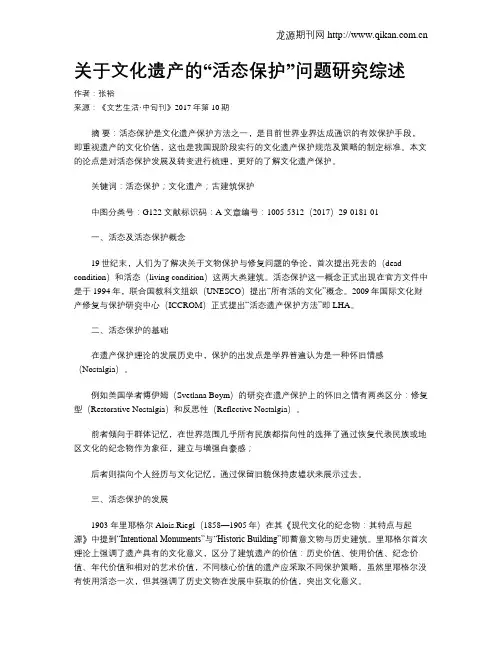
关于文化遗产的“活态保护”问题研究综述作者:张裕来源:《文艺生活·中旬刊》2017年第10期摘要:活态保护是文化遗产保护方法之一,是目前世界业界达成通识的有效保护手段,即重视遗产的文化价值,这也是我国现阶段实行的文化遗产保护规范及策略的制定标准。
本文的论点是对活态保护发展及转变进行梳理,更好的了解文化遗产保护。
关键词:活态保护;文化遗产;古建筑保护中图分类号:G122 文献标识码:A 文章编号:1005-5312(2017)29-0181-01一、活态及活态保护概念19世纪末,人们为了解决关于文物保护与修复问题的争论,首次提出死去的(dead condition)和活态(living condition)这两大类建筑。
活态保护这一概念正式出现在官方文件中是于1994年,联合国教科文组织(UNESCO)提出“所有活的文化”概念。
2009年国际文化财产修复与保护研究中心(ICCROM)正式提出“活态遗产保护方法”即LHA。
二、活态保护的基础在遗产保护理论的发展历史中,保护的出发点是学界普遍认为是一种怀旧情感(Nostalgia)。
例如美国学者博伊姆(Svetlana Boym)的研究在遗产保护上的怀旧之情有两类区分:修复型(Restorative Nostalgia)和反思性(Reflective Nostalgia)。
前者倾向于群体记忆,在世界范围几乎所有民族都指向性的选择了通过恢复代表民族或地区文化的纪念物作为象征,建立与增强自豪感;后者则指向个人经历与文化记忆,通过保留旧貌保持废墟状来展示过去。
三、活态保护的发展1903 年里耶格尔Alois.Riegl(1858—1905年)在其《现代文化的纪念物:其特点与起源》中提到“Intentional Monuments”与“Historic Building”即蓄意文物与历史建筑。
里耶格尔首次理论上强调了遗产具有的文化意义,区分了建筑遗产的价值:历史价值、使用价值、纪念价值、年代价值和相对的艺术价值,不同核心价值的遗产应采取不同保护策略。
维尼斯宪章——奈良真实性文件——北京文件国际古迹保护与修复宪章(第二届历史古迹建筑师及技师国际会议于1964年5月25日——31日在威尼斯通过)发文单位:第二届历史古迹建筑师及技师国际会议发文时间:1964-5-25生效日期:1964-5-25世世代代人民的历史古迹,饱含着过去岁月的信息留存至今,成为人们古老的活的见证。
人们越来越意识到人类价值的统一性,并把古代遗迹看作共同的遗产,认识到为后代保护这些古迹的共同责任。
将它们真实地、完整地传下去是我们的职责。
古代建筑的保护与修复指导原则应在国际上得到公认并作出规定,这一点至关重要。
各国在各自的文化和传统范畴内负责实施这一规划。
1931年的雅典宪章第一次规定了这些基本原则,为一个国际运动的广泛发展做出了贡献,这一运动所采取的具体形式体现在各国的文件之中,体现在国际博物馆协会和联合国教育、科学及文化组织的工作之中,以及在由后者建立的国际文化财产保护与修复研究中心之中。
一些已经并在继续变得更为复杂和多样化的问题已越来越受到注意,并展开了紧急研究。
现在,重新审阅宪章的时候已经来临,以便对其所含原则进行彻底研究,并在一份新文件中扩大其范围。
为此,1964年5月25日?31日在威尼斯召开了第二届历史古迹建筑师及技师国际会议,通过了以下文本:定义第一条历史古迹的要领不仅包括单个建筑物,而且包括能从中找出一种独特的文明、一种有意义的发展或一个历史事件见证的城市或乡村环境。
这不仅适用于伟大的艺术作品,而且亦适用于随时光逝而获得文化意义的过去一些较为朴实的艺术品。
第二条古迹的保护与修复必须求助于对研究和保护考古遗产有利的一切科学技术。
宗旨第三条保护与修复古迹的目的旨在把它们既作为历史见证,又作为艺术品予以保护。
保护第四条古迹的保护至关重要的一点在于日常的维护。
第五条为社会公用之目的使用古迹永远有利于古迹的保护。
因此,这种使用合乎需要,但决不能改变该建筑的布局或装饰。
只有在此限度内才可考虑或允许因功能改变而需做的改动。
关于原真性的“奈良文件”概要发布时间:2009-1-8 浏览量:801关于原真性的奈良会议于1994年11月1日—6日在日本奈良举行,主要讨论关于定义和评估原真性的大量复杂问题,对文化遗产的原真性概念及其应用作出详细阐述。
会议通过了《关于原真性的奈良文件》,是在1964年《威尼斯宪章》的精神基础上构思、建立延伸形成的,以回应当今世界对文化遗产关心和兴趣的扩展。
会议主要包括了文化多样性和遗产多样性、价值与原真性及其定义。
1.要基于遗产的价值保护各种形式和各历史时期的文化遗产。
人们理解这些价值的能力部分地依赖与这些价值有关的信息源的可信性与真实性。
对这些信息源的认识与理解,与文化遗产初始的和后续的特征与意义相关,是全面评估原真性的必要基础。
2.以这种方式考虑的、并在《威尼斯宪章》中确认的原真性,是与遗产价值有关的最为基本的资格因素。
在文化遗产的科学研究、保护与修复规划、以及依《世界遗产公约》规定的登录程序和其他文化遗产清单使用时,对原真性的理解扮演着重要的角色。
3.在不同文化、甚至在同一文化中,对文化遗产的价值特性及其相关信息源可信性的评判标准可能会不一致。
因而,将文化遗产的价值原真性置于固定的评价标准之中来是不可能的。
相反,对所有文化的尊重,要求充分考虑文化遗产的文脉关系。
4.因此,在每一文化内,对遗产价值的特性及相关信息源的可靠性与真实性的认识必须达成共识,这是至关重要、极其紧迫的。
5.基于文化遗产的本性以及文脉关系,原真性的判别会与各种大量信息源中有价值的部分有关联。
信息源的各方面包括形式与设计、材料与物质、使用与功能、传统与技术、位置与环境(这应该不是指场地,或场地只是其中一小部分概念)、精神与感受以及其它内在的、外部的因素。
允许利用这些信息源检验文化遗产在艺术、历史、社会和科学等维度的详尽状况。
Preamble1.We, the experts assembled in Nara (Japan), wish to acknowledge the generous spiritand intellectual courage of the Japanese authorities in providing a timely forum in which we could challenge conventional thinking in the conservation field, and debate ways and means of broadening our horizons to bring greater respect for cultural and heritage diversity to conservation practice.2.We also wish to acknowledge the value of the framework for discussion provided by theWorld Heritage Committee's desire to apply the test of authenticity in ways which accord full respect to the social and cultural values of all societies, in examining the outstanding universal value of cultural properties proposed for the World Heritage List.3.The Nara Document on Authenticity is conceived in the spirit of the Charter of Venice,1964, and builds on it and extends it in response to the expanding scope of cultural heritage concerns and interests in our contemporary world.4.In a world that is increasingly subject to the forces of globalization and homogenization,and in a world in which the search for cultural identity is sometimes pursued through aggressive nationalism and the suppression of the cultures of minorities, the essential contribution made by the consideration of authenticity in conservation practice is toclarify and illuminate the collective memory of humanity.Cultural Diversity and Heritage Diversity5.The diversity of cultures and heritage in our world is an irreplaceable source of spiritualand intellectual richness for all humankind. The protection and enhancement of cultural and heritage diversity in our world should be actively promoted as an essential aspect of human development.6.Cultural heritage diversity exists in time and space, and demands respect for othercultures and all aspects of their belief systems. In cases where cultural values appear to be in conflict, respect for cultural diversity demands acknowledgment of the legitimacy of the cultural values of all parties.7.All cultures and societies are rooted in the particular forms and means of tangible andintangible expression which constitute their heritage, and these should be respected.8.It is important to underline a fundamental principle of UNESCO, to the effect that thecultural heritage of each is the cultural heritage of all. Responsibility for cultural heritage and the management of it belongs, in the first place, to the cultural community that has generated it, and subsequently to that which cares for it. However, in addition to these responsibilities, adherence to the international charters and conventions developed for conservation of cultural heritage also obliges consideration of the principles and responsibilities flowing from them. Balancing their own requirements with those of other cultural communities is, for each community, highly desirable, provided achieving this balance does not undermine their fundamental cultural values.Values and authenticity9.Conservation of cultural heritage in all its forms and historical periods is rooted in thevalues attributed to the heritage. Our ability to understand these values depends, in part, on the degree to which information sources about these values may be understood as credible or truthful. Knowledge and understanding of these sources of information, in relation to original and subsequent characteristics of the cultural heritage, and their meaning, is a requisite basis for assessing all aspects of authenticity.10.Authenticity, considered in this way and affirmed in the Charter of Venice, appears as theessential qualifying factor concerning values. The understanding of authenticity plays a fundamental role in all scientific studies of the cultural heritage, in conservation and restoration planning, as well as within the inscription procedures used for the World Heritage Convention and other cultural heritage inventories.11.All judgements about values attributed to cultural properties as well as the credibility ofrelated information sources may differ from culture to culture, and even within the same culture. It is thus not possible to base judgements of values and authenticity within fixed criteria. On the contrary, the respect due to all cultures requires that heritage properties must considered and judged within the cultural contexts to which they belong.12.Therefore, it is of the highest importance and urgency that, within each culture,recognition be accorded to the specific nature of its heritage values and the credibility and truthfulness of related information sources.13.Depending on the nature of the cultural heritage, its cultural context, and its evolutionthrough time, authenticity judgements may be linked to the worth of a great variety of sources of information. Aspects of the sources may include form and design, materialsand substance, use and function, traditions and techniques, location and setting, and spirit and feeling, and other internal and external factors. The use of these sources permits elaboration of the specific artistic, historic, social, and scientific dimensions of the cultural heritage being examined.Appendix 1Suggestions for follow-up (proposed by H. Stovel)1.Respect for cultural and heritage diversity requires conscious efforts to avoid imposingmechanistic formulae or standardized procedures in attempting to define or determine authenticity of particular monuments and sites.2.Efforts to determine authenticity in a manner respectful of cultures and heritagediversity requires approaches which encourage cultures to develop analytical processes and tools specific to their nature and needs. Such approaches may have several aspects in common:o efforts to ensure assessment of authenticity involve multidisciplinary collaboration and the appropriate utilisation of all available expertise andknowledge;o efforts to ensure attributed values are truly representative of a culture and the diversity of its interests, in particular monuments and sites;o efforts to document clearly the particular nature of authenticity for monuments and sites as a practical guide to future treatment and monitoring;o efforts to update authenticity assessments in light of changing values and circumstances.3.Particularly important are efforts to ensure that attributed values are respected, and thattheir determination included efforts to build, ad far as possible, a multidisciplinary and community consensus concerning these values.4.Approaches should also build on and facilitate international co-operation among allthose with an interest in conservation of cultural heritage, in order to improve global respect and understanding for the diverse expressions and values of each culture.5.Continuation and extension of this dialogue to the various regions and cultures of theworld is a prerequisite to increasing the practical value of consideration of authenticity in the conservation of the common heritage of humankind..6.Increasing awareness within the public of this fundamental dimension of heritage is anabsolute necessity in order to arrive at concrete measures for safeguarding the vestiges of the past. This means developing greater understanding of the values represented by the cultural properties themselves, as well as respecting the role such monuments and sites play in contemporary society.Appendix IIDefinitionsConservation: all efforts designed to understand cultural heritage, know its history and meaning, ensure its material safeguard and, as required, its presentation, restoration and enhancement.(Cultural heritage is understood to include monuments, groups of buildings and sites of cultural value as defined in article one of the World Heritage Convention).Information sources: all material, written, oral and figurative sources which make it possible to know the nature, specifications, meaning and history of the cultural heritage.The Nara Document on Authenticity was drafted by the 45 participants at the Nara Conference on Authenticity in Relation to the World Heritage Convention, held at Nara, Japan, from 1-6 November 1994, at the invitation of the Agency for Cultural Affairs (Government of Japan) and the Nara Prefecture. The Agency organized the Nara Conference in cooperation with UNESCO, ICCROM and ICOMOS.This final version of the Nara Document has been edited by the general rapporteurs of the Nara Conference, Mr. Raymond Lemaire and Mr. Herb Stovel.。
原真性视角下的建筑遗产保护The document was finally revised on 2021原真性视角下的中国建筑遗产保护阮仪三李红艳【摘要】近年来,我国建筑遗产保护事业受到社会各界的高度关注,但在保护实践中却出现了种种误区,产生了大量的“建设性破坏”。
原真性是遗产保护的一条基本原则,对原真性理解差异会对建筑遗产的保护方法带来直接的影响。
该文通过回顾国际上关于历史古迹修复的思想渐进过程,对照《雅典宪章》、《威尼斯宪章》及《奈良原真性文件》等国际历史保存及古迹维护的重要文件,诠释建筑遗产保护“原真性”的内涵,指出我国建筑遗产保护中出现的理念和实践误区,探讨中国建筑遗产保护的途径。
【关键词】建筑遗产原真性保护创新原真性是文化遗产保护的核心概念之一,在我国,虽然原真性原则在文化遗产保护领域已得到公认,但是,对它的理解却存在很大差异,所以“原真性”理念指导下的保护实践也存在诸多争议。
与欧洲国家相比,我国建筑遗产保护尚处于起步阶段。
两个多世纪以来,欧洲对于原真性原则争论不断、研究不断,在不断的争议中,产生了比较成熟的保护理论与学说,对我国城市建筑遗产保护具有重要的借鉴作用。
1西方建筑遗产保护原真性认识的渐进过程20世纪以前,原真性并没有在城市遗产保护运动中被认为是关键的概念,但是,对于古建筑的修复方法却存在着很大争议(图1)。
1 9世纽中叶,对于建筑遗产保护,欧洲主要有两种互相对立又影响深远的学说1:一种是反干预的(Anti-interventionist),即历史性修复,基本在英国,代表人物是英国艺术理论家约翰·拉斯金( John Ruskin,1819年-1 900年),认为古建筑是匠人在一个特定的历史文脉中完成的独一无二的创作,不应用新的物质手段干预它的原有状态,当代的干预会带走历史的痕迹而使历史失真;另一种是主张干预的(lntervention ist),即风格性修复,代表人物是法国的厄杰纳·维奥莱一勒一丢克(Eugene Violbt- le-Duc,181 4年-1879年),可以理解为现在的人对过去事实完整而客观的呈现,赞成以必要的物质手段介入来保护历史建筑。
248作者简介:王孜(1995— ),男,汉族,山东济南人,硕士研究生。
主要研究方向:纺织科技史。
一、工业遗产的分类工业遗产可根据工业生产行业、尺度层级、历史阶段、创办主体的不同进行多种分类,同样工业遗产作为文化遗产的特殊类别,也有物质和非物质之分,本文将以此标准对工业遗产进行分类。
(一)物质工业遗产(1)建筑类:用于生产的作坊、厂房和车间等各类生产类建筑。
例如茅台酿酒作坊、青岛国棉五厂锯齿形主体厂房;服务于工业生产与工厂、矿区日常所需的类建筑。
例如上海铸币厂的蓄水塔、秦皇岛西港大码头;用于生产所需的仓库、地窖或山洞等其他仓储类别建筑。
例如井陉煤矿的正丰矿仓库、泸州老窖窖池群及酿酒作坊的天然藏酒洞;以及工业次生景观,包括工业废弃物堆场、矿区塌陷区、废弃露天采矿厂,例如大同煤业集团主采区。
(2)设备类:直接用于产品生产的生产类机器设备,例如青岛国棉五厂的44吋自动换梭织布机;服务于工业生产的机器机械和各类运输业等其他辅助类设备,例如核工业816工程所配套的取水制水装置。
(3)纪念物类:各类商标、牌匾、奖章、奖状及其他记录工业生产的物品。
例如开滦赵各庄矿所保存的图纸资料、“刘伯成”工厂曾经的朱德总司令任命书、石圪节煤矿曾获得的全国科学大会奖状等。
(二)非物质工业遗产(1)传统生产技艺类:在工业生产实践过程中逐渐累积经验、改进所形成且至今依然保留下来的足以代表某一行业最高生产、科技水平的生产技术和工艺。
例如传统棉纺织技艺、南京云锦木机妆花手工织造工艺等。
(2)档案、文学和口述类:在工业生产活动中所流传下来的各类档案文献、手稿、影音图书等资料文献,还包括以口耳相传形式所保存下来的关于工业方面的口碑文学、口头文学等其他口述史。
例如国营738厂保存的建厂以来的历史档案和影音资料、南京大学的“新中国工业建设口述史”项目等。
(3)工业表演艺术:在工业生产过程中所创造出足以表达当时表演者内心世界的各种表演形式,多以劳动歌曲为主,例如上海码头号子。
《奈良真实性文件》20年的保护实践回顾与总结——《奈良+20》声明性文件译介徐桐【摘要】“《奈良真实性文件》二十周年纪念国际会议”于2014年10月22-25日在日本奈良县举行.作为会议成果,在25日闭幕时通过了《奈良+20:关于遗产实践、文化价值和真实性概念的回顾性文件》.作为对20年来国际遗产保护发展中新的回应,刚通过的《奈良+20》文件继承了《奈良真实性文件》对于文化与遗产多样性背景下遗产“真实性”评判标准的思考,同时也基于20年来国际遗产保护实践的经验回顾与总结,回应了诸如多元利益相关者、遗产保护带来的冲突、以及遗产在可持续发展中的角色等在《奈良真实性文件》通过时井未凸显的相关议题.【期刊名称】《世界建筑》【年(卷),期】2014(000)012【总页数】2页(P106-107)【关键词】奈良+20;奈良真实性文件;真实性;遗产保护实践【作者】徐桐【作者单位】清华大学建筑学院【正文语种】中文为回顾1994年《奈良真实性文件》所设定的关于尊重世界范围内的文化和遗产多样性的原则;回顾此文件拓展了在遗产实践中关于遗产文化价值和真实性的概念;为确认在遗产保护实践中社区参与、社会包容、可续性的实践以及代际间责任的重要性;为承认意识到由于全球化、城市化、人口变动乃至新技术发展对遗产保护和传播带来的现实挑战;为认同不同社区群体在保持和传承其特有的、物质和非物质的文化表达方式上的权利;基于《奈良真实性文件》通过后的一系列国际公约和宪章以及学术研究和专业论坛的成果,拓展了文化遗产的涵盖领域,突出了文脉和文化多样性的重要性;日本文化厅为了纪念《奈良真实性文件》20周年,与九州大学合作举办了一系列专业会议,用以评估和学习20年来在文化遗产认定和管理中应用《奈良文件》的实践经验。
基于《姬路建议》,本文件认定,在全球、国家和地方文脉等各层面,广大社区和利益相关者采取的行动应当优先关注以下5个关联要素:如《奈良文件》所述,真实性随遗产所处文脉的不同而不同,而文化遗产的概念本身也包含多元的形式和演化进程。